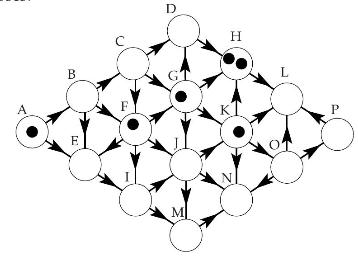Consider the following network (in technical terms, a directed graph or digraph). Each circle, here marked with
Question:
Consider the following network (in technical terms, a directed graph or "digraph"). Each circle, here marked with one of the letters A to P, represents a node of the network. Some of these nodes (here A, F, G, H, and K) have counters on them. There can be any number of counters on a node, like currently the two counters on H. In a move, one of the counters is moved to a neighbouring node in the direction of the arrow as indicated, for example from \(\mathrm{F}\) to \(\mathrm{I}\) (but not from \(\mathrm{F}\) to C, nor directly from F to D, say). Players alternate, and the first player no longer able to move loses.
(a) Explain why this game fulfills the ending condition.
(b) Who is winning in the above position? If it is the first player to move, describe all possible winning moves. Justify your answer.
(c) How does the answer to
(b) change when the arrow from \(\mathrm{J}\) to \(\mathrm{K}\) is reversed so that it points from \(\mathrm{K}\) to \(\mathrm{J}\) instead?
Step by Step Answer:






